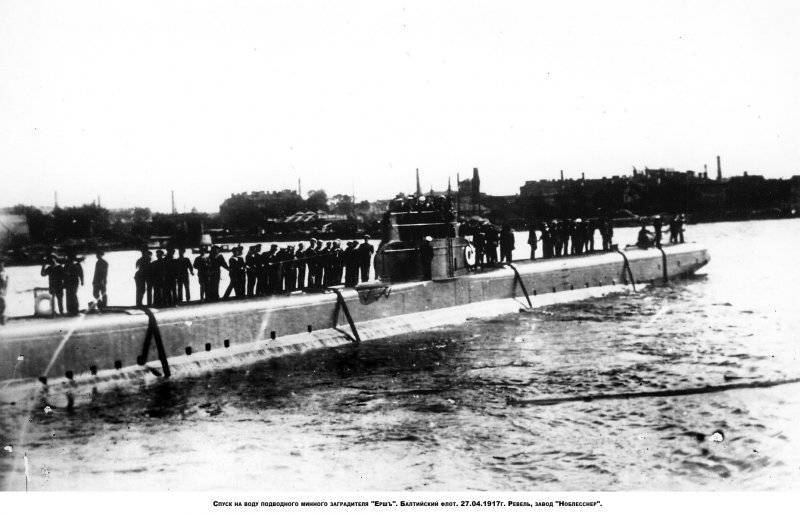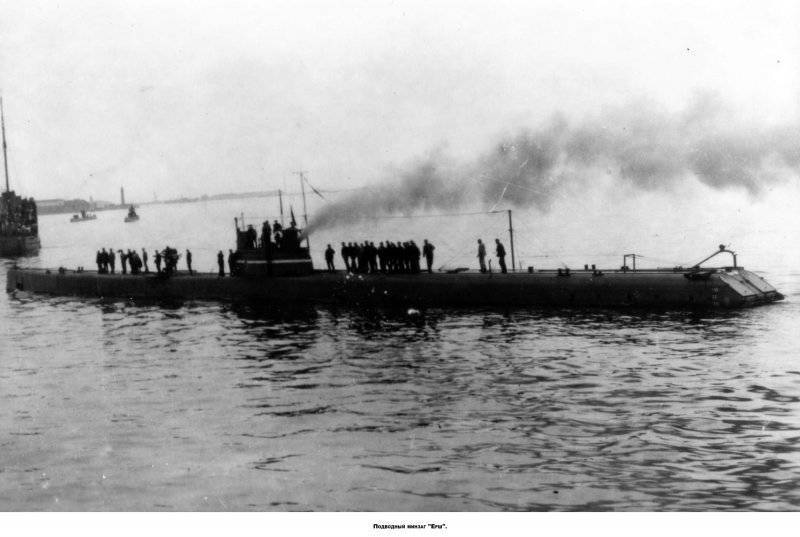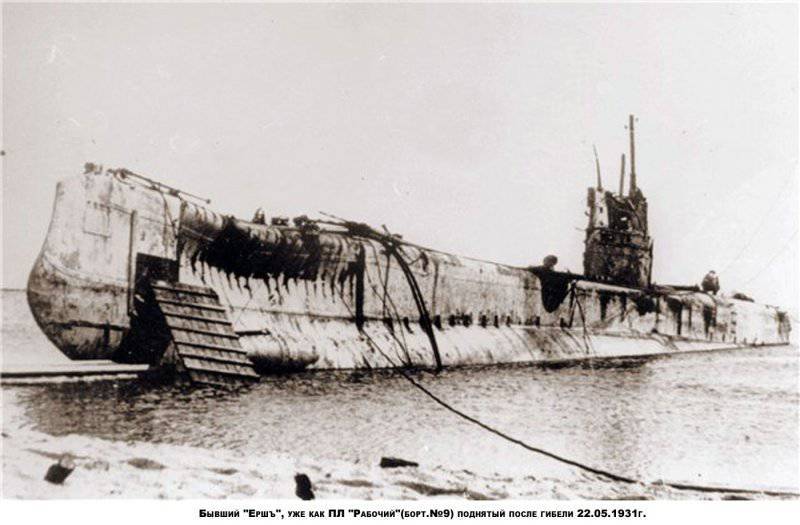Yorsh submarine mine loaders
According to the technical task of the Department of scuba diving HUK, the “mines throwing device” should have been as close as possible to the mine director of the minelayer Crab. The device should have been provided with the automatic setting of mines with an interval of 30,5 meters at an underwater speed from four knots to the maximum speed of the submarine. The entire mine device was designed to use an existing sample of “PL” mines with zero buoyancy. These mines were armed with an underwater minelayer "Crab".
Above the project of re-equipment of the submarine "Trout" worked: marine engineer lieutenant KI Ruberovsky, head of those. Bureau of the Scuba Diving Department of the Baltic Shipyard; ship engineer lieutenant Tokmakov EM; Vasilyev VI, the designer. During the works, the design drawings of the submarine "Crab" and the working drawings of the vessel, which were available in the submarine brigade of the Black Sea Fleet and in the ONZiV plant (the Society of Nikolaev Plants and Shipyards), were used. In October 1916 of the year - at the final stage - Ruberovsky KI and his colleagues were studying the submarine "Crab" in Sevastopol, and for consultations a mine conductor of the underwater minelayer Tantsura Semen arrived in Petrograd with drawings. The project took into account the opinion of the commander of the submarine "Crab" of senior lieutenant Parutsky MV
The initial design of the Trout submarine redevelopment at the end of October 1916 was approved by MGSH and the diving department of the State Management Company. At the same time, "to preserve stability and better anti-grid protection," they decided to abandon the Dzhevetsky lattice mine apparatus, having placed two Whitehead spare mines in their noses and mounted an 57 caliber gun before cutting. The General Directorate of Shipbuilding 26 in October 1916 of the year issued an order for the Baltic Plant to re-equip the Trout submarine into a minelayer. 1 May 1917, the year was set to be ready.
By this time, in addition to the Baltic plant, the development of similar projects was also carried out by the ONZiV and the Nobelner Revel plant. The attraction of the Noblessner plant can be explained by the petition of the Vice Admiral Commander of the Baltic Fleet, A. Nepenin. about the completion of the "Tur" submarine, built at this plant, mine layer. The “Tour” re-equipment project at the Noblessner plant was performed in September-October on 1916 of the year under the supervision and, probably, under the overall supervision of the staff captain of the naval engineer Yurkevich V.I. (hereinafter - the chief designer of the French liner "Normandy"). But the Noblessner plant 5 of November 1916 of the year refused to fulfill the order, since it could not guarantee its fulfillment by the spring of 1917 of the year.
Captain of the first rank Bykov BA, the head of the diving department, did not approve the project of the Noblessner plant, since it proposed a completely new mine device designed for execution. Rightly believing impossible to use it without comprehensive testing (as it was done on the submarine "Crab"), Bykov BA pointed out the advantages of the option proposed by the Baltic plant.
The opinion of the diving department was decisive when ordering the second mine layer for the Baltic Fleet, which Vice-Admiral A. Nepenin insisted on.
The Baltic plant 11.11.1916 was given an outfit for re-equipment in accordance with the approved project of the submarine "Trout" of another submarine - "Ruff" - with the same period of readiness. The project of the minelayer, drawn up in October-December 1916 of the ONViZ year, was not implemented due to the refusal of the Black Sea submariners to re-equip Bars (Swan) submarines already under construction into minelayers. The commander of the submarine brigade, Captain of the first rank, V. Klochkovsky at the same time, he explained that the Black Sea Fleet did not have enough conventional submarines, and one Krab submarine was enough for laying mines. In the fall of 1915, the submarines "Yorsh" and "Trout", originally built by the Noblessner plant, were transferred to the Baltic Shipyard. The body of the “Yorsh” submarine by this time was collected by about 60 percent, and the berthing works on the submarine “Trout” were not carried out “because of the remoteness of the deadlines”. During the transfer of the order to Petrograd from the Noblessner plant, 80 tons of processed steel were delivered by rail for the Ruff submarine and 94,5 tons for the Trout submarine. At the Baltic Shipyard, the shipbuilding engineer Pavel Yankov was appointed submarine builder. By 01.01.1916, he managed to bring the general readiness of the Trout submarine to 14,36 percent (the beginning of the construction of 09.11.1915), and the Ruff submarine (the beginning of the construction of 11.10.1915) to 20,4 percent of full readiness.
The hulls of both submarines were completed in October 1916 of the year, so the placement of the “mine-setting apparatus” required serious alterations in the rear part. This circumstance and technical difficulties in the execution of the mine device, as well as the low discipline of deliveries by counterparties, made inevitable a breakdown of the established readiness dates.
The strikes at the start of 1917 delayed construction by about a month. It was not possible to compensate for this lag "due to the temporary cancellation of overshearse work, the 8-hour working day, and the loss of administration and craftsmen." As a result, the submarine "Yorsh", launched in the summer, only in the fall was able to present in Revel for tests.
The submarine “Trout”, which had lagged behind it, from which, during construction, temporarily removed parts for the repair of the submarine “Cheetah”, was lowered into water in November and remained in winter at the plant wall. In November-December, 1917 was tested by an underwater mine layer “Ersh” by a commission chaired by P. P. Levitsky. by abbreviated program. The headquarters of the submarine division, on the basis of the results of the tests, petitioned the Military Department of Tsetrobalt to enroll the Erash submarine on the fleet list with 28.12.1917.
The fundamental differences between the underwater mine layer Ersh and the prototype Bars submarine were in the type of main diesel engines and the composition of the mine armament. In the stern of the lightweight superstructure (140-218 frames), 42 "PL" mines were staggered in two rows. Mines "PL" moved along the rails using a worm shaft, which was rotated by an electric motor, the rotational speed of which varied in the range from 600 to 1000 revolutions per minute depending on the speed of the submarine. Thus, mines were set up at intervals of 30,5 meters in the submarine speed range from 4 to 12 nodes. To move and fix the mines on the tracks, the leading rollers of the anchors and guides of the vehicle served. The total weight of the “mine thrower” (without the mass of the rails and the superstructure) was 2,5 tons.
The initial project, which was approved for the submarine "Trout", provided for the installation of a pair of stern and a pair of nasal tubular torpedo tubes for Whitehead mines of 457 mm caliber with two spare torpedoes located in the bow. Mines "PL" were taken into overload, and therefore with the "overhang of the stern" in the surface position, the submarine had a trim about 40 " Whitehead’s spare torpedoes were also abandoned. The surface displacement of the “Ersh” submarine actually amounted to 655 tons, and the submerged displacement - 750 tons. Artillery weapons also changed: one 57-millimeter cannon was replaced 75 mm caliber (fire rate - 10 shots per minute, 20 elevation angle degrees), installed a 37 mm anti-aircraft gun and antiaircraft guns. Screws and rudders were streamlined, and the body without protruding parts, smooth.
An important improvement of the “Yorsh” submarine compared with the “Leopard” was the installation of a lower manhole hatch, which excludes the possibility of the submarine's death during the flooding of the cabin, and also the transfer of control to the central post. The control of periscopes, vertical rudder, blowing and ventilation of deck and middle tanks was transferred to the central post. In order to increase the volume of the central post, the height of the leveling tank was reduced. The main 420-strong diesels of the American form "New London" were installed on the submarine mine layers "Yorsh" and "Trout". On the tests, the speed of the submarine "Ruff" in the surface position was 10,75 nodes. The fuel supply component of the 32 ton provided the cruising range of the 1000 miles at full speed, and the 1400 miles at economic speed. Submarine "Ersh" did not participate in hostilities. She in February 1918 of the year together with other submarines of the division made the transition to Helsingfors from Revel, and in April 1918 of the year took part in the ice campaign of the ships of the Baltic Fleet. In the autumn of 1918, the sub-ship "Ruff" was delivered to the port for long-term storage.
The submarine "Trout" and could not be put into operation. At the beginning of 1918, its completion was suspended at 90 percent availability. By this time, only the battery, galley and electric motors for the steering actuators were installed on the submarine. The estimate of the Marine Department, which allocated 425 thousand rubles for the completion of the submarine "Yaz" and "Trout" in July-December 1918, remained on paper.
Based on the operational situation in the Baltic on the summer of 1919, Altfater V.M., Commander of the Republic Naval Forces, ordered in December 1918 to issue an urgent repair order for the repair of the Yorsh submarine and the completion of the Trout submarine. In Kronstadt port there were 80 mines "PL" (of which 38 were delivered with the second submarine), 56 anchors and 237 bodies of such mines that were delivered earlier from G.A.Lessner. The mine drills conducted in 1918 by the crew of the “Ersh” submarine showed an unreliable separation from the mine anchors. They hoped to eliminate the drawback in the spring of the following year, but the state of the industry did not allow to fulfill the plans. In 1919, the current Baltic Sea detachment was left without submarine minelayers.
The sub-ship "Yorsh" in October 1919 was transferred to Lake Ladoga, and from there it returned to the Baltic only in July 1921, joining the Second Division of the Brigade of submarines of the Naval Forces of the Baltic Sea. The unfinished submarine "Trout" in the fall of the same year examined specials. Commission chaired by ship engineer Shershov AP It was decided to finish building a fence at the Baltic Shipyard to navigate 1922 of the year. To preserve the hull of a submarine for the winter, 1921-1922 was recommended to inspect and clean the bottom of rust and dirt, paint and coat it with oil. In order to avoid rupture of the pipelines, the commission recommended that “fill up the underwater holes with manure, heat up with stones”.
Due to the absence of some mechanisms, the Trout submarine until 1925 remained in the list of "ships destined for completion". During the preparation of the new shipbuilding program (in 1926), the obsolete submarine was finally abandoned; from 1929, its hull was used as a tool for training lifts by the rescue ship Kommuna, later it was dismantled for metal.
The sub-ship "Ersh" underwent a major overhaul in 1922-1924. 31 December 1922, the minelayer was given the new name “Worker” (tail number 9), was in the submarine brigade of the Naval Forces of the Baltic Sea. Submarines "No. 9" and "No. 4" ("Leopard", hereinafter "Red Army") 21 of May 1931, under the general command of the submarine "Worker" Tsarevsky N.A. (he is the battalion commander) went to the western part of the Gulf of Finland on a training trip to work out joint surface navigation. In the vicinity of the Ehrensgrund lighthouse at night 22 in May, the submarine "No. 4" in stormy weather during the turn on the course of 200 degrees violated the rules of maneuvering by striking the stern of the submarine "No. 9". "9 No." with a big trim went under water for 3-5 minutes.
Perhaps, after the collision, the submarine commander Tsarevsky N.A. hoped to keep the ship afloat by pumping out the incoming water. The entire top watch went down, closing the manhole hatch, but it did not work out a hole - the commander and all 45 submariners died.
The commission recognized as the culprits of the catastrophe Timanova I.V., watch supervisor of the submarine "No. 4" (he was appointed to the submarine three days before the release), commander of the submarine Atavin AD. (appointed 17.02.1931), military commissar Tolkachev V.N. All three were arrested and convicted. Narkomvoenmor Voroshilov K.E. arrived in Kronstadt scolded submariners for low discipline. The fever caused by the accident caused the next reshuffle and the passage of combat training of crews "from scratch", without departing from the pier. At the same time, the Revolutionary Military Council noted: "The response of personnel to the death of the submarine number 9 ... healthy", which was expressed in the growth of party ranks, enthusiasm and the collection of money for the construction of a new submarine.
According to Admiral Platonov V.N., who at that time served in the submarine brigade, the main causes of the accident were the "obsolete" level of the minelayer, the decay of the hull and equipment, the absence of transverse bulkheads, and the low level of training of submariners. Immediately after the catastrophe, the search began for the dead, but it was located at depths up to 80 meters, which did not allow us to immediately achieve results.
EPRON 21 July 1933 of the year with the help of the rescue ship "Commune" (formerly "Volkhov") raised a sunken underwater mine layer; then it was scrapped.



Information